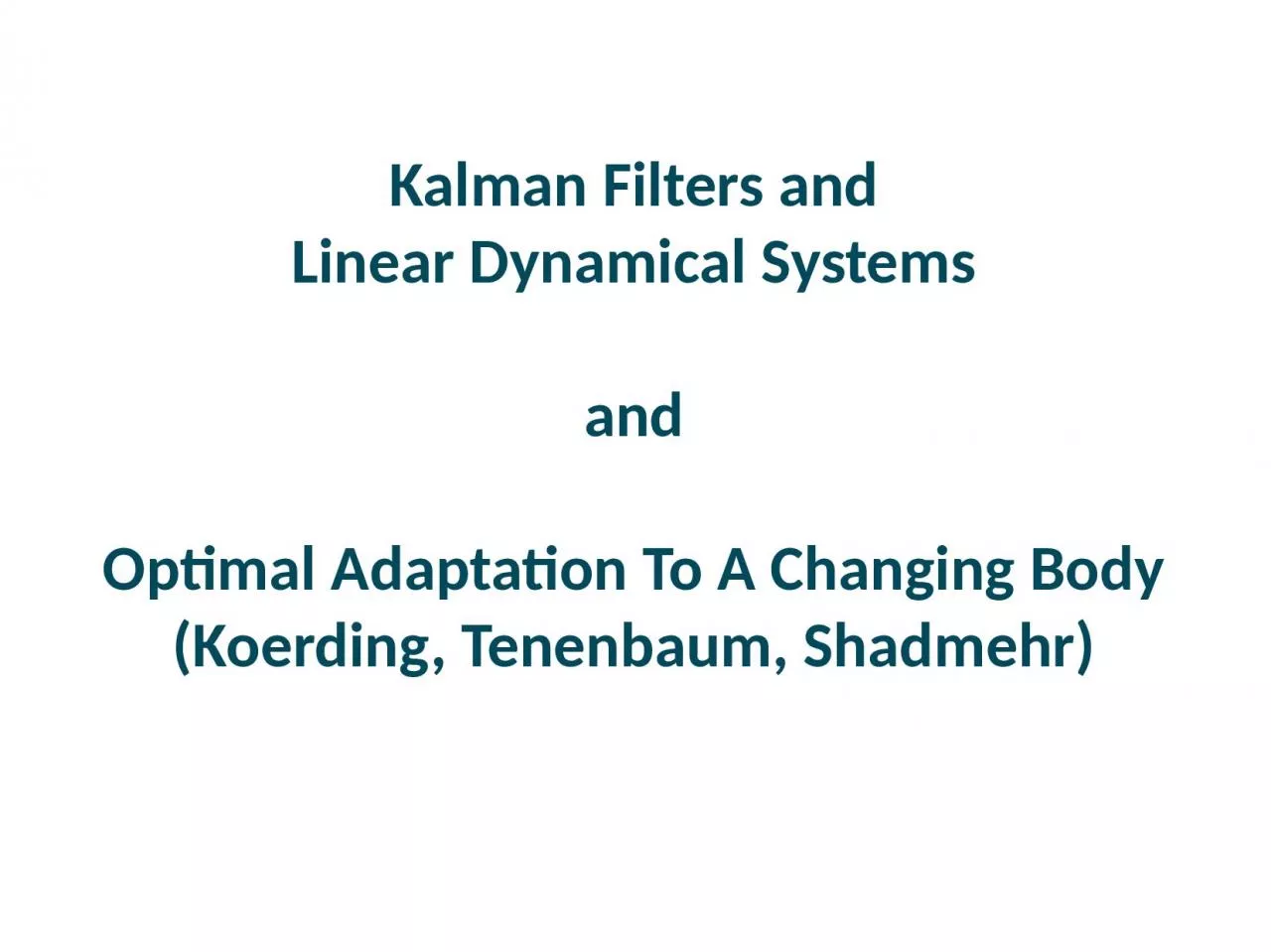

and Optimal Adaptation To A Changing Body Koerding Tenenbaum Shadmehr Tracking Cars people in video images GPS Observations via sensors are noisy Recover true position Temporal task ID: 931372
Download Presentation The PPT/PDF document "Kalman Filters and Linear Dynamical Syst..." is the property of its rightful owner. Permission is granted to download and print the materials on this web site for personal, non-commercial use only, and to display it on your personal computer provided you do not modify the materials and that you retain all copyright notices contained in the materials. By downloading content from our website, you accept the terms of this agreement.
Slide1
Kalman Filters and
Linear Dynamical Systems
and
Optimal Adaptation To A Changing Body
(
Koerding
, Tenenbaum,
Shadmehr
)
Slide2Tracking
{Cars, people} in {video images, GPS}
Observations via sensors are noisyRecover true positionTemporal taskPosition at t is determined in partby position at t-1face tracking demoobject tracking demomultiple person tracking demo (offline demo)
Coifman et al.
Slide3Bayesian Formulation
Prior
Predicted position of object based on previous position and velocityLikelihoodNoisy observationPosteriorBayesian update
Slide4Graphical Model Formulation With Time
X
t: state (position, velocity) at time tZt: observation (image, GPS data) at time tP(Xt|Xt-1): state dynamics (how vehicle/person moves)P(Z
t|Xt): observation dynamics (how observations are generated)
X
1
X
2
X
3
Z
1
Z
2
Z
3
Slide5HMM Versus State Space Model
HMM
X is discrete; Z is often discreteTransition distribution is look up tableState-space modelX and Z are continuous vectorsDynamics (Xt→Xt+1, X
t→Zt) are arbitraryLinear state-space modelState-space model with linear dynamics
Kalman filter
Linear state-space model with additive Gaussian noise
X
1
X
2
X
3
Z
1
Z
2
Z
3
Slide6Kalman Filter Generative Model
Dynamics: linear stochastic difference equation
Observation modelNoise distributionsWhat distributions do x and z have?
X1X
2
X
3
Z
1
Z
2
Z
3
U
1
U
2
U
3
Slide7Kalman Filter
Assumes known dynamics and observation model, but that can be learned as well
Offline: EM algorithmOn-line: Gradient ascent in log likelihoodUsesPredictionSmoothing (noise reduction)Uncertainty estimationOptimal: minimizes estimation error
Credit: Hal
Daumé
III
Slide8Kalman
Filter Inference
X1X2
X3
Z
1
Z
2
Z
3
U
1
U
2
U
3
Reliability of observation vs. internal prediction
X
1
X
2
X
3
Z
1
Z
2
U
1
U
2
U
3
Mean of predicted X
k-1
given all observations to k-1
Mean of predicted
X
k
given all observations to k-1
Slide9Extensions
Nonlinear dynamics
Extended Kalman filterParticle filterSwitched linear dynamicsE.g., running vs. walking vs. climbing
Z1Z2
Z
3
X
1
X
2
X
3
S
1
S
2
S
3
Slide10Motor Adaptation
Thought experiment
Walking on the moonMany reasons for changing response of musclesFatigueDiseaseExerciseDevelopment
Slide11Simple Example
Saccadic eye movement to target
Adaptation taskMotor error -> gain adjustment
error
Slide12Time Scale
When muscles are perturbed, what is the
time scale of the perturbation?Fatigue: a few minutesDisease/injury: monthsExercise: months to yearsDevelopment: lifetimeAny adaptation to perturbation should last only as long as the time scale of the perturbation.Key ideaNeed to represent perturbations at multiple time scales
TerminologyPerturbation = Disturbance = Deviation of gain from default (1.0)
Slide13Generative Model of Disturbances:
Random Walk At Two Time Scales
Slide14Kalman
Filter Model Of Adaptation
X: vector of internal gain disturbances, one per time scaleZ: net gain disturbanceτ : something like number of time steps for state to decay τ=1 (fast time scale) vs. τ=100 (slow time scale)Large τ -> less memory of past, more noise -> rapid increase in uncertainty over time
X1
X
2
X
3
Z
1
Z
2
Z
3
Slide15Credit Assignment
Net observed disturbance is sum of slow and fast
Why is there a tendency to move ↑ instead of →?
After
prolonged
exposure to
disturbance:
shift from fast
to slow scale
Slide16Saccadic Gain Adaptation
Maintained perturbation
leads to slow shift from fast
time scale to slow time scale
Two phases of gain
Adaptation (30% shift)
Note that final state is not the same as initial state, even though behavior is identical.
Slide17Model claim: Forgetting occurs because monkey makes eye movements without
feedback → greater uncertainty over time
Multiday study: 1500
trials per day, followed
by dark goggles.
Features:
(1) Day-to-day
forgetting;
(2) faster
relearning
Phase 1
Phase 2
Slide18Double Reversal Experiment
Slow states positive;
fast states negative
Tgt
jump: +35% -35% +35%
Slide19Double Reversal Experiment II
During dark period, decay of to zero at all
at all time scales. Faster decay for
faster time scales.
Because slow time scales are positive,
net increase in gain
No intrasaccadic
target steps
Increased uncertainty -> rapid
learning
Slide20Relation To Human Memory
Effect of relearning
Faster to relearn material than initial acquisitionEffect of spacingMaterial is better remembered if the time between study sessions is increased
Slide21Relevance To AI / Machine Learning
Robotics
Any agent dealing with complex, nonstationary environment needs to adapt continuouslyBut also needs to remember what had been learned earlierHCIIf you’re going to design a system that adapts to users, it must have memory of user at multiple time scales